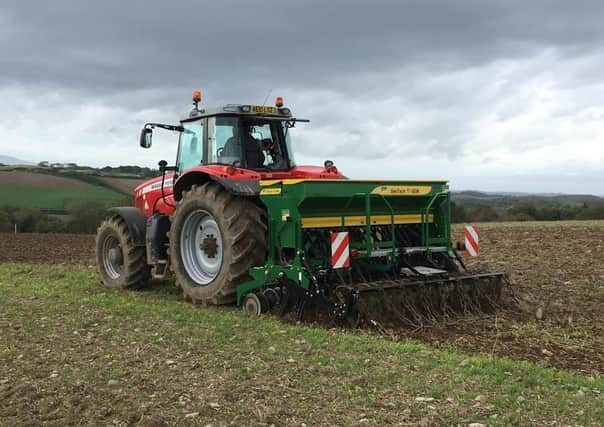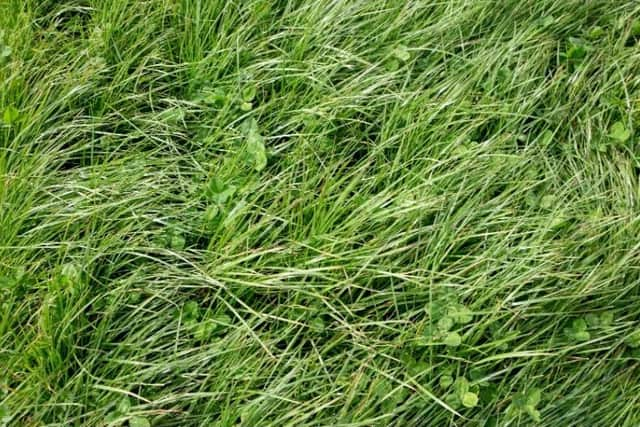Sow the reseed and reap the reward


The temperate climate in Northern Ireland ensures that we are in an ideal position to grow quality grass for grazing and forage production.
College of Agriculture, Food and Rural Enterprise (CAFRE) Beef and Sheep Adviser Rachel Megarrell recommends that farmers should consider implementing a reseeding/sward improvement plan on their farm with the aim of maintaining swards at their most productive. Research at Teagasc Moorepark shows that old permanent pasture produces on average 3t DM/ha/yr less than Perennial ryegrass (PRG) dominated swards and is up to 25% less responsive to available nutrients such as nitrogen then PRG dominated swards.
Advertisement
Advertisement
The first step in the improvement process is identifying the least productive fields on the farm, do so by walking the farm and select for reseeding according to age and quality of the current ley. PRG can be identified within the sward by the following characteristics; a red stem base, sheaths and back of the leaves are smooth and shiny and the upper surface of the leaf is strongly ribbed. If grass species in the sward are correctly identified then sward composition can be assessed and if there is less than 40% PRG then sowing out is a feasible option. When the sward deteriorates it allows weeds and less productive grass species to enter the sward and this is a key indicator that reseeding would be beneficial.


Consideration should also be given to other management reasons that lead to poor sward quality such as overgrazing, understocking and poor utilisation, poaching, late silage cuts with long intervals, poor nutrition, acidic soil and poor drainage.
In addition to considering the state of the original sward it is important to review the methods that are available for improvement as detailed in Table 1.
On a practical level before any operation commences a soil analysis needs to be completed to assess nutrient requirements. Grass grows best at pH range of 6.0-6.5 and if the soil pH drops below this and becomes more acidic, other less productive grasses take over and white clover disappears. Reseeds will deteriorate at a faster rate under acidic soil conditions and this can be overcome by applying lime to ploughed ground prior to reseeding. Lime is best applied after ploughing but before secondary cultivations for a reseed. The aim of the cultivations should be to prepare a fine, firm seedbed without causing too much loss of moisture in the top few inches of the soil. Following sowing rolling is crucial to help conserve moisture levels, improve germination and give an even sowing depth.
Advertisement
Advertisement
Grass seed accounts for approximately 30% of the cost of a reseed and therefore careful consideration should be given to the appropriate choice. Selecting a grass seed mixture should be carried on an individual farm/field basis and a number of questions should be addressed prior to selecting a mix. What is the planned use of the field being reseeded? What is the soil type? How much fertiliser should be spread on this ground?


In agriculture grass species are divided into two categories; Preferred which are mainly ryegrasses and Timothy and less preferred such as Bent and Annual Meadow grass. Swards dominant in ryegrasses and Timothy do not occur naturally in N.I and must be sown. Less-preferred grass species will gradually invade reseeded grassland, especially if poorly managed. The most productive plants for intensive grassland conditions include PRG and white clover. PRG is the most important and widely used species in Northern Ireland seed mixtures as they have rapid establishment and a high nutritive value exhibiting persistent, palatable and high yielding characteristics. Italian ryegrass (IRG) is the highest yielding of all ryegrass groups and is suitable for intensive silage use however it is short lived lasting approximately three years. Hybrid ryegrass is a cross between PRG and IRG designed to combine the high yield of IRG with the long life of PRG. Hybrids are mostly utilised in silage swards and they tend to be higher yielding than PRG but not as persistent.
High prices for nitrogen fertiliser increases the interest of clover inclusion in a grass seed mix. Clover is a leguminous plant that has the unique ability to convert or ‘fix’ nitrogen naturally from the atmosphere and use it at root level in a form that can be used by the plant. This process is carried out by bacteria (Rhizobia spp) which live in the nodules on the roots of healthy clover plants.
When properly managed white clover inclusion in swards offers the opportunity to reduce the input of chemical nitrogen in grass swards. Not only does this represent a cost saving financially but is of continuing importance at an environmental level. The management of your sward post sowing will determine the inclusion of clover. Clover safe post emergence sprays will be required or alternatively clover can be stitched in 6 weeks after spraying.
Advertisement
Advertisement
Perennial ryegrass varieties are divided into three maturity groups, Early, Intermediate and Late and these need to be considered for example if the field is for silage, look for varieties with traits for high D-value and dry matter yield. Remember that heading dates approximately 10 days after your planned cutting date are required to ensure you achieve maximum silage quality. A close range of less than 7 days between the heading dates of the varieties within the mixture will allow for better management of your sward. For example early varieties will exhibit high yielding qualities in early spring and will be suitable for early turnout and early silage harvest whereas the intermediate varieties are suited to use in most grassland enterprises and are suitable for cutting to achieve 67D.
Normally grasses are diploids which means they have two chromosomes in the cell nucleus whereas tetraploids have four chromosomes. Diploid varieties are predominately for increased ground cover while tetraploids have a tall growth pattern and can be more open on wetter soils.
If carrying out sward rejuvenation methods such as stitching in, increase the proportion of tetraploid in the grass mix as the bigger seed is more aggressive while establishing in the existing sward.
Always use the Recommended Grass Clover Lists (RGCL) which includes varieties produced by the DAERA funded AFBI grass breeding programme at Loughgall. These grasses have been bred and trialed under Northern Ireland environmental conditions and information such as average yield potential, maturity, spring growth and persistence is available.
Advertisement
Advertisement
Finally it is important to consider the general management of a newly sown sward. The aim post sowing is to achieve a densely tillered, leafy sward. Graze the sward on an on-off basis once the seedlings have established. First grazing will be approximately 6 weeks after sowing, this encourages seedlings to produce more tillers and therefore improves sward density. It is preferable to graze with sheep or stock lightly with young cattle as sheep poach less than cattle. Weeds need to be monitored and controlled early as they will reduce tillering of the sward. Some weeds will be killed by grazing however others will require herbicide application for effective control. Ensure the sward is well grazed before winter as high grass covers are prone to frost damage.
In conclusion, reseeding will produce an improvement in the quality of grass swards on your farm leading to increased palatability and digestibility, improve grass growth and response from nitrogen fertiliser, enable higher stocking rates to be carried and enhance silage yields.